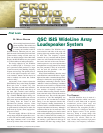
Copyright 2005 JRS Publishing, Inc.Reprinted with permission.
BY WAYNE BECKER
Q
SC has widely been known for their
power amplifiers. Their reliable and
accurate sound has been a mainstay
in touring and installed sound for
decades. However within the past two years,
QSC has made a bid for their place in the loud-
speaker market, coming out with some very
good, cost effective designs. One of their latest
designs, the ISIS WideLine array has opened
to a critical audience of audio professionals.
The design objective for the WideLine
array as stated by QSC is “To design a com-
pact system that would perform as a larger
system in terms of power handling, frequency
response and coverage. The primary focus is
to be on the regional corporate user in ball-
room situations, theaters and the myriad of
small to medium size events that confront
such users daily.”
And recently, I had a chance to demo the
ISIS WideLine arrays at the Trump Taj Mahal
Hotel and Casino in Atlantic City, New
Jersey. The demo was held in the main ball-
rooms A&B along with the entire line up of
the latest QSC installed sound offerings.
QSC did it up right with a full live rig includ-
ing a Yamaha DM2000 digital mixing con-
sole, a host of outboard effects and of course
QSC power amps and loudspeaker processors
all running under the control of their
QSControl.net platform software, Venue
Manager. And not only did they have various
program material, but they had an entire live
band made up of piano, drums, upright bass,
guitar and vocalist.
The room roughly 150 feet x 150 feet was
mostly empty, had plush carpeted floors, stuc-
co walls and some moveable partitions, your
basic huge conference room. A few chairs
were set up in front of the room in the middle
section for attendees. The WideLine arrays
were hoisted to both sides of the stage area
sporting eight array modules along with subs
on both sides. The frequency response
seemed to be very consistent and the pattern
control was well controlled from the front of
the room to the back of the room. The hori-
zontal response was very even and articulated
throughout the coverage pattern. Even though
the room presented a delay off of the back
wall, the stack still presented a clear and
unmarred direct field presence.
What I liked immediately about the sound
of the WideLine is that it didn’t have a “hyped”
high end, but rather a smooth midrange transi-
tioning to a clean but not overly bright top end.
Although not overbearing, I did notice a bit of
“tubbiness” in the lower midrange, I attributed
that to the room. Overall I was impressed with
the wide horizontal coverage and linear and
even transition of frequency response as I
moved to different seating locations from the
front to the back of the room and from side to
side between arrays. The roll off of the pattern
was decisive as well. The intelligibility was
good, even in this less-than-ideal acoustical
setting. I was also impressed with the mid-
range frequency shading demonstration. It
seemed to make a noticeable difference in the
response and behavior of the array. Although I
would have liked to do a few more tests with a
male and female speaking voice, the live sound
of the vocalist and the program material of var-
ious artists (I selected the CDs) certainly pro-
vided me with enough proof that these arrays
are certainly a good solution for this type of
environment and other stage settings where
quick set-up and quality sound are required.
THE PRODUCT
The ISIS WideLine Array is made of a
lightweight composite cabinet, and comes
in black or white finish with an optional
weatherized version (black only) and
weighs about 70 pounds. Its multiple aper-
ture diffraction slot waveguide provides a
wide dispersion of 140 degrees horizontal
and 10 degrees vertical. It also provides
three-way, biamp or triamp design with
selectable frequency shading between the
enclosure’s two woofers, which are 10-
inch, 16-ohm long excursion, high power
(380 watts), low-frequency transducers.
REPRINTED FROM AUGUST, 2005 WWW.PROAUDIOREVIEW.COM
First Look
QSC ISIS WideLine Array
Loudspeaker System




